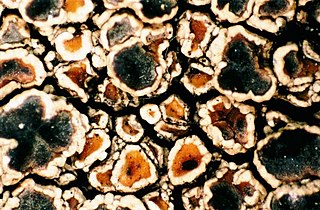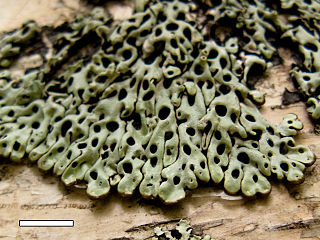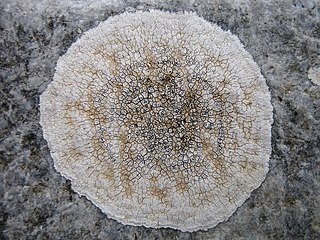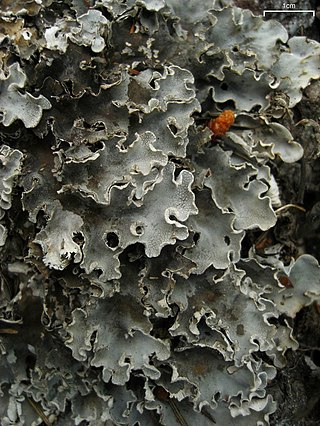
Aspicilia is a genus of mostly crustose areolate lichens that grow on rock. Most members have black apothecia discs that are slightly immersed in the areolas, hence the common name"Given the same reason, the naming of Aspicilia is derived from the Greek word for "shield concave".

Megasporaceae are a family of fungi belonging to the order Pertusariales. Taxa are lichenized with green algae, and grow on rocks, often in maritime climates close to fresh water. Phylogenetic analysis has shown that this family is related to the Pertusariaceae, another family of lichens. The genus Aspicilia was moved here from the Hymeneliaceae.

The Pertusariales are an order of fungi in the class Lecanoromycetes, comprising 8 families, 31 genera, and over 600 species, many of which form lichens. This diverse group is characterized by complex taxonomic history and ongoing phylogenetic revisions. Originally proposed by Maurice Choisy in 1949 and later formally published by the lichenologists David L. Hawksworth and Ove Eriksson in 1986, Pertusariales has undergone significant reclassification due to molecular phylogenetics studies. The order includes well-known genera such as Pertusaria and Ochrolechia, as well as families like Megasporaceae and Icmadophilaceae.

Menegazzia is a genus of lichenized fungi containing roughly 70 accepted species. The group is sometimes referred to as the tree flutes, honeycombed lichens, or hole-punch lichens. The most obvious morphological feature of the genus is the distinctive perforations spread across the upper side of the thallus. This makes the group easy to recognise, even for those not particularly familiar with lichen identification.
Rhizocarpon diploschistinum is an uncommon species of lichenicolous (lichen-dwelling), crustose lichen in the family Rhizocarpaceae. It parasitises the lichen Diploschistes muscorum. It is distinguished from similar species by its distinctive yellow thallus and presence of rhizocarpic acid. This lichen has been found in shrub steppe and grasslands in central Washington and north-central Oregon, USA.

Crustose lichens are lichens that form a crust which strongly adheres to the substrate, making separation from the substrate impossible without destruction. The basic structure of crustose lichens consists of a cortex layer, an algal layer, and a medulla. The upper cortex layer is differentiated and is usually pigmented. The algal layer lies beneath the cortex. The medulla fastens the lichen to the substrate and is made up of fungal hyphae. The surface of crustose lichens is characterized by branching cracks that periodically close in response to climatic variations such as alternate wetting and drying regimes.

Circinaria is a genus of crustose lichens in the family Megasporaceae. It was circumscribed by Johann Heinrich Friedrich Link in 1809.

Megaspora is a genus of lichen-forming fungi in the family Megasporaceae. It contains four species of crustose lichens that typically grow on soil, bryophytes, or plant litter on chalky substrates.

Circinaria caesiocinerea is a species of crustose lichen belonging to the family Megasporaceae. It was first described as Lecanora caesiocinerea in 1869 by William Nylander, but was transferred to the genus Circinaria in 2010 by Anders Nordin, Sanja Savić, and Leif Tibell.
Teuvoa is a genus of lichen-forming fungi in the family Megasporaceae. It was first classified by lichenologists Mohammad Sohrabi and Steven Leavitt in 2013, with Teuvoa uxoris assigned as the type species. This genus was delineated from the larger genus, Aspicilia, following a molecular phylogenetic analysis which revealed that the Aspicilia uxoris species group constituted a distinct lineage in the Megasporaceae. Initially containing three species, two additional species native to China were added in 2018. Teuvoa is characterised by its small ascospores and conidia, and the absence of secondary metabolites.

Circinaria calcarea is a species of crustose lichen in the family Megasporaceae. It was first described as a new species by Carl Linnaeus in his 1753 work Species Plantarum. Linnaeus named it Lichen calcareus, as he classified all lichens in the eponymously named genus. The species has had an extensive taxonomic history, resulting in dozens of synonyms. In 2010, it was placed in its current genus, Circinaria, following molecular phylogenetic analysis of the Megasporaceae.
Buellia dijiana is a species of terricolous (ground-dwelling), crustose lichen in the family Caliciaceae. It is found in Australia.

Peltigera rufescens, commonly known as the field dog lichen or field pelt, is a species of terricolous (ground-dwelling), foliose lichen in the family Peltigeraceae. This common and widespread species has a cosmopolitan distribution, often found in dry, sunny habitats on basic soils, limestone, and nutrient-rich silicate substrates. The lichen forms rosettes up to 20 cm in diameter, with a grey to brown thallus densely covered with a soft, velvety tomentum. Its lobes, typically 3–5 cm long and 5–10 mm wide, have distinctively curled upward edges. The underside features a network of veins and rhizines, which anchor the lichen to its substrate. P. rufescens reproduces both sexually through apothecia and asexually via regeneration lobes. It forms a symbiotic relationship with cyanobacteria from the genus Nostoc as its photobiont. The species is notable for its ability to bioaccumulate heavy metals and its adaptive responses to UV-B radiation, making it a subject for ecological and physiological studies.

Ochrolechia upsaliensis is a species of crustose lichen in the family Ochrolechiaceae. Found in the Northern Hemisphere, it is commonly known as the tundra saucer lichen.

Solorina crocea, commonly known as the orange chocolate chip lichen, is a species of terricolous (ground-dwelling) and foliose (leafy) lichen in the family Peltigeraceae. The lichen, which was first formally described by Carl Linnaeus in 1753, has an arctic–alpine and circumpolar distribution and occurs in Asia, Europe, North America, and New Zealand. It generally grows on the bare ground in sandy soils, often in moist soil near snow patches or seepage areas. Although several forms and varieties of the lichen have been proposed in its history, these are not considered to have any independent taxonomic significance.
Oxneriaria is a genus of lichen-forming fungi in the family Megasporaceae. It has nine species, all of which are saxicolous (rock-dwelling), crustose lichens. The genus was circumscribed in 2017 by Sergey Kondratyuk and László Lőkös to contain species formerly in the Aspicilia mashiginensis species group. This species, now the type of the genus, was first described scientifically by Alexander Zahlbruckner as Lecanora mashiginensis. The genus name honours Ukrainian lichenologist Alfred Oxner, who, according to the authors, "provided important contribution [sic] to taxonomy of aspicilioid lichens and to biodiversity of polar lichens".
Heppia arenacea is a species of terricolous (ground-dwelling) lichen in the family Lichinaceae. Discovered in Yemen, it is characterized by its sand-coloured thallus and the incorporation of soil particles throughout its vegetative parts. The lichen is found in soil crust communities over limestone and basaltic rock in desert habitats, as well as in partially sheltered areas between large boulders.
Schaereria bullata is a species of lichen in the family Schaereriaceae. It is found in the alpine regions of Tasmania, Australia. This lichen species is characterized by its dark brown to grey-brown thallus, which forms irregular patches over soil or bryophytes, and consists of granules that coalesce to create convex to bullate squamules. The lichen also features distinctive apothecia, which are roundish and typically superficial, and spherical spores.
Caloplaca sterilis is a corticolous (bark-dwelling), crustose lichen belonging to the family Teloschistaceae, described in 2011. It is primarily found in steppe and sand dune habitats in the Black Sea region, and has been recorded from Bulgaria, Romania, southwest Russia, and Ukraine. Caloplaca sterilis is characterised by tiny squamules/areoles with contrasting pale greyish-green to greenish soredia. It is easily overlooked and challenging to identify when completely sorediate and sterile, especially as its soredia do not contain the typical Sedifolia-grey pigment.

Aspiciliella is a genus of lichen-forming fungi in the family Megasporaceae. It has four species. The genus is characterised by its crustose, rimose-areolate thallus that is partially continuous and has a K+ (red) reaction. The epihymenium is typically green to olive-green and turns light green when treated with N. Aspiciliella has eight-spored asci of the Aspicilia-type, containing ellipsoid, colourless, and simple ascospores.












